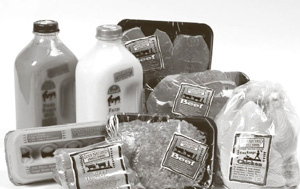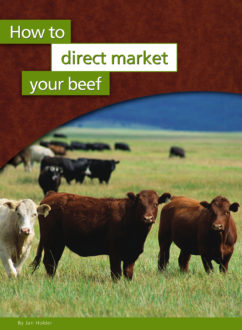
Bulk ground beef is most economically packaged in small bags, usually referred to as chubb bags. They come in 1-, 2- and 5-pound sizes, and you can select from different thicknesses of plastic. You can buy them pre-printed with some standard design, and then have your label affixed when they are filled at the processing plant. When your quantities are higher (5,000 and above), you can have your label pre-printed on the bag. There are only a few chubb bag companies around. Don’t purchase really cheap bags, as cheap bags tend to get holes during the filling process. Seek food service equipment and supplies sources online.
Recently, we have changed our ground beef packaging to a Styrofoam tray with a perishable food wrapping. Our processor still occasionally had trouble with pin holes in the chubb bags. Even though it is more expensive, in the end it made our customers and us happier, not to have packages that had to be returned due to defects.
Most consumers will not buy a product that they cannot see, especially if they’ve never bought it before. So package your beef in clear plastic perishable food wrap-ping, vacuum packed. It is more expensive, but important not only so the consumer can see what he or she is getting, but also so the product stays fresh longer. Food wrap-ping, such as Cryovac®, gives meat a longer shelf life than paper-wrapped meat. The higher cost is offset by these benefits.
Package your beef in convenient sizes. We have found that the person who typically buys our product tends to eat smaller portions than your average meat consumer. At the supermarket, ground beef is usually sold in 1 ½- to 2-pound packages. Our customers complained that that was too large. So now we sell our ground beef, ground beef patties, stew beef, and fajita beef in 1-pound packages, steaks two-to-a-package, tenderloin at ¾ of a pound per package, New York strips at 1 pound per package, rib eyes at 1 pound, 3 ounces per package, roasts at 3 pounds each and beef jerky at 1 ounce per package.
If you wind up selling to a distribution source – such as a restaurant, natural foods distribution company, or a retail store – instead of directly to a consumer, they will inquire about case sizes. Generally we have found it is best to have a case big enough that the cost of cardboard doesn’t kill you, but it won’t mean too large of an investment in one order.
Also, weight is a factor. A lot of women are employed as warehouse workers these days. Don’t make up cases weighing over 35 or 40 pounds. Our cases are usually 24 pounds. You need to label all cases with the product codes (we use the standard codes listed in the beef buyers guide unless we have come up with a cut that is not listed – then we make up our own).
UPC CODES
Some retailers want you to include bar coding or a Universal Product Code (UPC). That is the little code on your product that identifies your company and its location to the store, and may contain other information including the product price. Bar coding is new for meat products. We have never had a client insist upon it, which is good, as it does add cost to the bottom line.
There are many websites that detail how to get a bar code onto your label. Any processed product (such as hot dogs, jerky, etc.) will require a UPC code. Some producers join the Universal Product Code organization, which charges a one-time fee. The Universal Product Code association is on the Internet at www.uc-council.org.
A ranching friend buys all his bar codes from a private company he finds cheaper and faster: www.buyabarcode.com. Their one-time fee of $75 is a bargain compared to the $800 charged by the UPC Council, and the bar codes are only $35 each. More-over, you don’t have to sort through new software to download a code.
Then, consider three ways to get your bar code on your product:
- Contact a printing company that prints UPC bar code labels, which can then be applied to your product.
- Have a UPC bar code printed directly on the package of your product.
- Print UPC bar code labels yourself using off-the-shelf software.
INSURANCE
Some of your customers – mostly retail stores, restaurants and some farmers markets – will require you to carry product liability insurance. This is a separate policy from your normal ranch or farm insurance. It’s not all that big of a deal. Most places require $1 million in liability. Present a “certificate of insurance” to your client whenever you meet them for the first time. If they demand it, it will save some time. If they don’t, you will look all the more respectable and trustworthy.
